Royal Front Hand Mehndi Design
Royal Front Hand Mehndi Designs are the epitome of elegance and traditional beauty. These elaborate patterns are often reserved for grand occasions like weddings and festivals, where the Royal Front Hand Mehndi Design on the front of the hand is meant to make a powerful visual impact. Inspired by royal Mughal art and heritage, these designs are rich in detail, symmetry, and symbolism.

What Defines a Royal Front Hand Mehndi Design?
Royal Mehndi designs go beyond ordinary patterns by embracing complex motifs, intricate grids, symmetry, and full coverage. The focus is on making the hand look like a canvas of regal artwork. Often, the fingers, palms, and even wrists are filled with patterns that seamlessly connect in harmony.
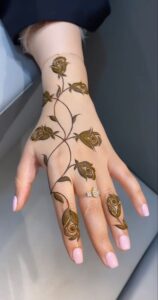
Common Elements in Royal Mehndi:
- Peacock motifs: Symbolizing beauty and elegance.
- Mandala circles: Representing unity and eternity.
- Checkered patterns: For royal finesse and structure.
- Intricate floral vines: Flowing from the fingertips to the wrist.
- Jali (net) work: Inspired by palace windows and Mughal architecture.
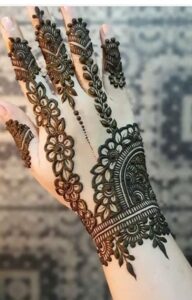
When to Wear Royal Front Hand Mehndi
This style is perfect for:
- Brides on their wedding day
- Bridal showers or Mehndi nights
- Engagement and Sangeet ceremonies
- Festivals like Eid, Diwali, and Karva Chauth
- Photoshoots or cultural fashion events
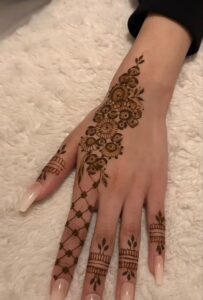
Styling Tips
- Pair with heavy jewelry like bangles, haathphools, or rings.
- Choose deep red or maroon henna for a royal effect.
- Wear traditional outfits like lehengas, sarees, or anarkalis.
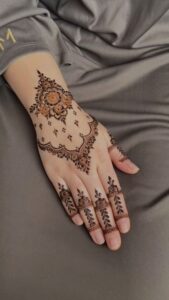
FAQs About Royal Front Hand Mehndi Design
How is royal Mehndi different from Arabic or simple designs?
Royal Mehndi is denser and more detailed, often covering the entire hand with symmetrical and ornate patterns, unlike the minimalism seen in Arabic designs.
How long does it take to apply royal front hand Mehndi?
Depending on the complexity, a full royal design can take 1.5 to 3 hours per hand.
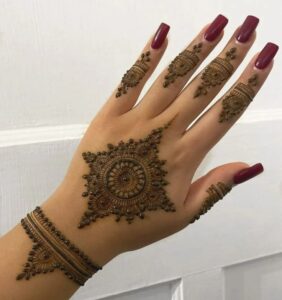
What type of henna is best for a royal look?
Natural henna that gives a dark reddish-brown stain is ideal. Some artists also use cone-based herbal henna for precision.

Can I combine royal front-hand design with a simpler backhand design?
Yes. Many brides opt for a heavy royal front and a lighter backhand for a balanced, elegant appearance.

How do I maintain the Mehndi color for longer?
Avoid water and soap for the first 12 hours. For a darker stain, apply a mixture of lemon juice and sugar and wrap your hands to lock in the heat overnight.
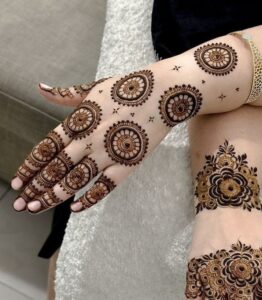
The Appeal of Minimalist Henna
Simple designs work because they focus on clean lines and purposeful patterns. A single well-placed motif often creates more impact than covering every inch of skin with intricate details. This approach makes mehndi accessible to busy people who want beautiful results without spending hours in application.
The versatility of simple patterns means they complement any style or occasion. From office gatherings to weekend festivals, these designs strike the perfect balance between traditional artistry and contemporary aesthetics.
Popular Simple Pattern Types
Floral Motifs Made Easy
Start with basic flower shapes like roses or daisies. A single large bloom on your palm, surrounded by simple leaves and thin vines extending toward fingers, creates an elegant foundation. Small floral clusters on fingertips add delicate finishing touches that feel complete without being overwhelming.
Clean Geometric Patterns
Straight lines, triangles, and dots arranged symmetrically offer modern appeal. Try a simple mandala in your palm’s center with geometric accents radiating outward. These structured patterns are forgiving for beginners since slight imperfections often go unnoticed within the overall design.
Minimalist Motifs
Small symbols like hearts, stars, or infinity signs work beautifully on wrists or fingers. These tiny designs pack surprising visual impact while requiring minimal time and skill to execute properly.
Tips for Success
Practice basic strokes on paper before applying henna to skin. Keep your cone pressure steady for consistent line thickness. Start with designs on less visible areas, like the wrist, before attempting hand patterns.
Most importantly, embrace imperfection. Simple mehndi designs should feel organic and personal, not machine-precise. Your unique style emerges through practice and experimentation with these foundational patterns.

